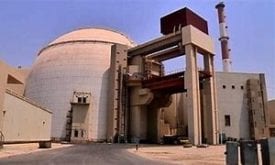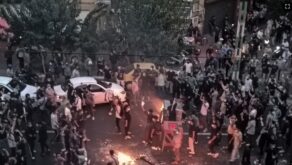Al-monitor — It was Ayatollah Ali Akbar Hashemi Rafsanjani’s last journey in Tehran. The 82-year-old symbol of the 1979 Islamic Revolution in Iran was given a hero’s goodbye, with hundreds of thousands of Iranians accompanying his coffin many kilometers on foot. People held up images of him — some new, some old, some with President Hassan Rouhani, a few with former Reformist President Mohammad Khatami, and many with Iran’s Supreme Leader Ayatollah Ali Khamenei, who led the funeral prayers before Rafsanjani’s body.
AUTHOR Ali Hashem
The controversies and contradictions that surrounded his life were also reflected on his burial day. Everyone who turned out seemed to want to say that Rafsanjani belonged to them. Conservative and Reformist supporters clashed by shouting rival chants. It was impressive to see that several hours of tension involving young people did not turn into something far worse. Still, the opposing mourners almost shouted in each other’s faces, with the identity of each side obvious from the images they raised, the clothes they wore and the slogans they yelled.
“Today is a day of mourning, our leader Khamenei, we came to soothe your pain,” shouted a group of conservatives in front of Tehran University, where the funeral prayers were being held. “Oh Hossein, Mir Hossein,” responded a group of Reformists who were referring to former presidential candidate Mir Hossein Mousavi, one of their leaders who has been under house arrest since 2011. The chants continued without interruption. Even the huge megaphone used by the organizers was unable to halt the exchange of slogans. Those who did not take part in the chanting competition watched, with some taking videos and photos with their phones and some smiling at the scene.
A young man raised high a poster with the images of Khamenei and Rafsanjani smiling at each other. Underneath the images was written “Khoda Hafez Rafiq” (Goodbye Comrade), also the title of a famous Iranian movie. “Today is a sad day for all Iranians,” the young man told Al-Monitor. “It’s not easy to imagine Iran without Hashemi. He’s a history book, a symbol, the scent of the Imam [Ruhollah] Khomeini, the close friend of the [supreme] leader. He occupies a large part of our memories. It’s not easy.” While the young man walked away, a woman watching him speak burst into tears as she embraced a poster with the words “Hashemi is alive.” She gathered her words: “He’s like a father to us. Even when there were differences, he was always working for the Revolution.” The woman, who was wearing a black chador, concluded, “The [supreme] leader is alone now. His close friend is gone, and I feel the pain for him.”
As the funeral prayers at Tehran University came to an end, people started walking toward a designated area. The plan was to reach Hafez Street and the truck carrying the coffin would then continue its way to the mausoleum of Ayatollah Khomeini, where Rafsanjani was to be buried. As people walked along with the coffin, the crowd grew bigger. There were people everywhere — on a bridge, beneath it, in the alleyways, on side streets. Reformist mourners seized the moment; their chants became louder and louder. “Hashemi’s death is our sorrow, we have people who need to be given their rights, and Hashemi won’t mind if we use his funeral to make ourselves heard,” a young woman told Al-Monitor. She added, “Now that he’s dead, we have a lot to say. We lost someone who supported us, someone whom we might have had differences with but knew that we could count on. Hashemi is a loss for anyone thinking of a new Iran.”
An old man walking alone with a newspaper on his head stopped beneath a big poster of Rafsanjani and started reading poetry. “I fought under an army commanded by Hashemi during the Imposed [1980-88 Iran-Iraq] War,” the man said. “I worked for the government that Hashemi headed. I’m not like the youth who heard of Hashemi through family, or saw him in the past few years playing politics. I’m one of those who experienced him and know what we are losing today.” The old man elaborated, “He was wise, he was courageous: a cleric with the brain of a genius, a politician with the skills of a doctor. Those of his caliber today are few.”
Three women wearing black chadors walked hand in hand behind two ambulances moving slowly on a bridge, thinking that Rafsanjani’s body was inside. They read prayers with a sad voice, and each time they finished they shouted, “There is no God but God, and Muhammad is the messenger of God.” People started gathering around them, but then everyone on the bridge started running and crying. People rushed to see what was going on. The vehicle that was actually carrying Rafsanjani’s body was getting closer to the crowd at this point — the coffin on top of the truck, with the ayatollah’s turban atop the coffin. Some went to take pictures and record the moment, while others just stood and watched.
At Khomeini’s mausoleum, Rafsanjani’s family members and officials were taking care of the burial arrangements. A new grave was dug beside the resting place of the founder of the Islamic Republic. People were pouring into the venue, many who came on foot, some who came by car and others who used the metro. Finally, Rafsanjani’s last journey came to an end.
 Shabtabnews In this dark night, I have lost my way – Arise from a corner, oh you the star of guidance.
Shabtabnews In this dark night, I have lost my way – Arise from a corner, oh you the star of guidance.


